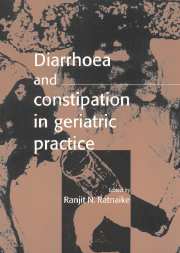Book contents
- Frontmatter
- Contents
- List of contributors
- Preface
- Acknowledgments
- Foreword by Gary R. Andrews
- I Defences of the aging gastrointestinal tract
- II Diarrhoea
- III Noninfectious clinical entities
- 11 Coeliac disease
- 12 Inflammatory disorders of the colon
- 13 Neoplasia and diarrhoea
- 14 Irritable bowel syndrome
- 15 Endocrine, metabolic and miscellaneous causes of diarrhoea
- IV Constipation
- V Perspectives of altered bowel function
- Index
13 - Neoplasia and diarrhoea
Published online by Cambridge University Press: 17 August 2009
- Frontmatter
- Contents
- List of contributors
- Preface
- Acknowledgments
- Foreword by Gary R. Andrews
- I Defences of the aging gastrointestinal tract
- II Diarrhoea
- III Noninfectious clinical entities
- 11 Coeliac disease
- 12 Inflammatory disorders of the colon
- 13 Neoplasia and diarrhoea
- 14 Irritable bowel syndrome
- 15 Endocrine, metabolic and miscellaneous causes of diarrhoea
- IV Constipation
- V Perspectives of altered bowel function
- Index
Summary
Introduction
The gastrointestinal tract is one of the most common sites of tumour. The malignancies of the lower gastrointestinal tract, predominantly carcinoma of the colon and of the rectum, are responsible for one in eight of all deaths from cancer. This is exceeded only by carcinomas of the lung. In the USA approximately 160 000 new cancers of the lower gastrointestinal tract will be diagnosed each year.
Tumours arise in populations of dividing cells. They are clonal and arise secondary to a single or multiple genetic mutation in a dividing cell. It is at cell division, when the cell's DNA is being copied, that permanent changes in the genome of that cell will occur. Populations of cells, therefore, such as those at the epithelial surfaces of the colon and lung, and hematopoietic cells, where the proliferation of cells is active, are prone to the development of cancer.
Adenocarcinomas are responsible for most of the morbidity and mortality associated with tumours of the gastrointestinal tract. Other neoplasia such as the tubular adenomas are extremely common and seldom of consequence. Adenomatous polyps are now recognized as having potential for malignant transformation. Up to 10 per cent of all colorectal cancer can be related to primary inherited genetic abnormalities while up to 70 per cent of all colorectal cancers will have predisposing genetic factors.
Tumours of the gastrointestinal tract may present late due to a lack of specific symptoms.
- Type
- Chapter
- Information
- Diarrhoea and Constipation in Geriatric Practice , pp. 154 - 161Publisher: Cambridge University PressPrint publication year: 1999



